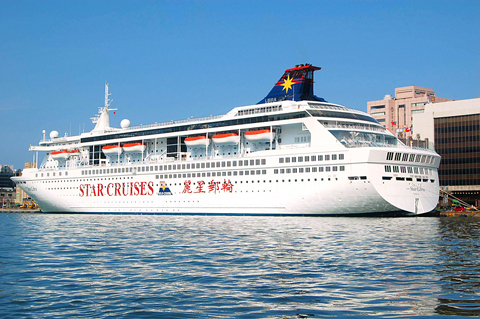Star Cruises (麗星郵輪), the largest cruise line in the Asia-Pacific, said yesterday that it may consider withdrawing from the Taiwanese market if Taiwanese authorities deny its application to operate a direct cruise service between the northeastern port of Keelung and Xiamen, Fujian Province.
Star Cruises filed the application with the Keelung Harbor Bureau last month to serve the route, but the screening process has turned out to be a frustrating experience for the company, as government officials and the cruise line’s executives disagree over the nature of the service.
Ministry of Transportation and Communication officials said that regular cruises between Keelung and Xiamen would amount to marine passenger services, which only Taiwanese vessels or vessels owned by Taiwanese-Chinese joint ventures are allowed to operate under local regulations.

PHOTO: LU HSIEN-HSIU, TAIPEI TIMES
The Hong Kong-based Star Cruises said, however, that ordinary people are unlikely to use expensive cruises as “passenger services.”
Transportation officials have suggested that Star Cruises add another destination to the line to make the operations look more like a cruise than a ferry service.
Star Cruises has yet to decide whether the suggestion is acceptable, but sources at the company said an initial evaluation has shown that the proposed change would be much less attractive than the originally planned route.
The sources said that Star Cruises has already reduced its workforce in Taiwan by 70 percent amid the global economic downturn. The company was to close its operations in Taiwan early last year, but delayed the action after seeing a glimmer of hope in proposed cross-Taiwan Strait talks on direct shipping between Taiwan and China.
Star Cruises entered Taiwan’s maritime tourism market in 1997, sailing primarily between Keelung and Japan’s Okinawa. The cruise line stopped sailing this route in October 2005, but resumed the service in June 2007.
The company has been the major player in Taiwan’s cruise market, taking local tourists on cruises to the Japanese islands of Okinawa, Ishigaki and Yonaguri, Taiwan’s Penghu islands and Hong Kong. When the weather turns cold, its ships leave Taiwan to serve Star Cruises’ other Asian routes.
At the time when Star Cruises resumed homeporting in Keelung, Star Cruises’ Taiwan manager Andy Lew (盧冠群) openly indicated that from a long-term point of view, Star Cruises wanted to launch services from Taiwan to Shanghai and Xiamen — two of China’s port cities.
Taiwan and China reached agreements in November to lift a six-decade ban on direct sea and postal links between the two sides and expand air links.
Foreign cruise ships visiting Taiwan now no longer need to sail to a third territory, usually Hong Kong, before they can visit a Chinese port, or vice versa.
If Star Cruises terminates its operations in Taiwan, the port of Keelung will lose at least NT$7 million in harbor fees a year from its home port, and tourism-related businesses will lose revenues from tourists who dock at Keelung on 80 cruises between March and September every year.

GROWING CONCERN: Some senior Trump administration officials opposed the UAE expansion over fears that another TSMC project could jeopardize its US investment Taiwan Semiconductor Manufacturing Co (TSMC, 台積電) is evaluating building an advanced production facility in the United Arab Emirates (UAE) and has discussed the possibility with officials in US President Donald Trump’s administration, people familiar with the matter said, in a potentially major bet on the Middle East that would only come to fruition with Washington’s approval. The company has had multiple meetings in the past few months with US Special Envoy to the Middle East Steve Witkoff and officials from MGX, an influential investment vehicle overseen by the UAE president’s brother, the people said. The conversations are a continuation of talks that

With an approval rating of just two percent, Peruvian President Dina Boluarte might be the world’s most unpopular leader, according to pollsters. Protests greeted her rise to power 29 months ago, and have marked her entire term — joined by assorted scandals, investigations, controversies and a surge in gang violence. The 63-year-old is the target of a dozen probes, including for her alleged failure to declare gifts of luxury jewels and watches, a scandal inevitably dubbed “Rolexgate.” She is also under the microscope for a two-week undeclared absence for nose surgery — which she insists was medical, not cosmetic — and is

Nintendo Co hopes to match the runaway success of the Switch when its leveled-up new console hits shelves on Thursday, with strong early sales expected despite the gadget’s high price. Featuring a bigger screen and more processing power, the Switch 2 is an upgrade to its predecessor, which has sold 152 million units since launching in 2017 — making it the third-best-selling video game console of all time. However, despite buzz among fans and robust demand for pre-orders, headwinds for Nintendo include uncertainty over US trade tariffs and whether enough people are willing to shell out. The Switch 2 “is priced relatively high”

Alchip Technologies Ltd (世芯), an application-specific integrated circuit (ASIC) designer specializing in artificial-intelligence (AI) chips, yesterday said that small-volume production of 3-nanometer (nm) chips for a key customer is on track to start by the end of this year, dismissing speculation about delays in producing advanced chips. As Alchip is transitioning from 7-nanometer and 5-nanometer process technology to 3 nanometers, investors and shareholders have been closely monitoring whether the company is navigating through such transition smoothly. “We are proceeding well in [building] this generation [of chips]. It appears to me that no revision will be required. We have achieved success in designing